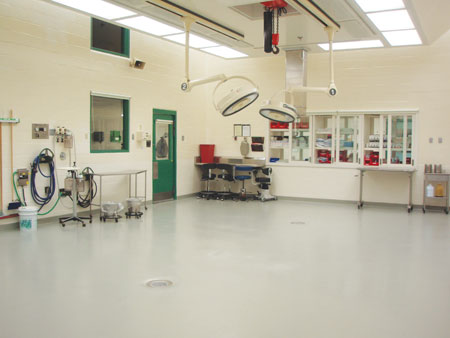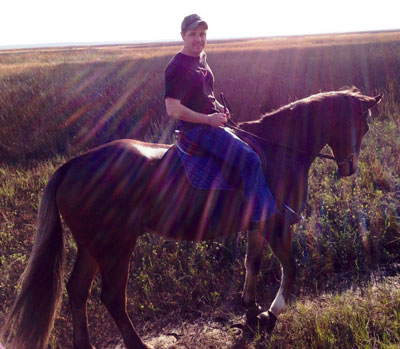Exercise Intolerance

Since Courtney first got Andy, he had always been an all-around perfect horse. Courtney and Andy showed in the jumper ring together, went on trail rides, and even fox hunted. Andy loved working and was a great horse to ride.
However, in 2011, Courtney noticed that Andy was showing signs of exercise intolerance during routine workouts. Andy was only 10 years old and in great shape, so Courtney knew that this wasn’t a normal sign of aging. The exercise intolerance, along with “roaring,” i.e. making a “roaring-like” noise on inspiration and difficulty breathing, led Courtney to call her local veterinarians in the Ocala area. After these visits were inconclusive, Courtney researched specialty veterinarians to help her.
“I spoke to several local horse owners to evaluate my options for a veterinarian,” Courtney said. “Positive feedback about the University of Florida Large Animal Hospital made me decide to schedule an initial appointment.”
At UF, Courtney was greeted by Dr. Alison Morton, Director of the Equine Lameness & Imaging Service and Associate Professor of Large Animal Surgery at the University of Florida College of Veterinary Medicine. After gathering Andy’s history and Courtney’s latest observations, Dr. Morton performed a complete physical examination.
“Andy had a prominent left muscular process of his arytenoid cartilage of his larynx, which is common with laryngeal hemiplegia,” Dr. Morton said. “This meant that he likely had some degree of paralysis in his larynx, preventing him from getting enough air in during heavy breathing during exercise.”
Standing and Treadmill Endoscopy at UF

Dr. Morton and her team performed a standing endoscopy on Andy to evaluate his upper airways. The endoscopy showed that Andy’s pharynx and nasal passages were normal, but his left arytenoid opened more slowly than his right.
The left arytenoid was a concern for Dr. Morton, and she wanted to see what it did when Andy was exercising, because some horse’s arytenoid function improves with exercise and some will worsen. The University of Florida Large Animal Hospital is equipped with a high-speed treadmill. Experienced technicians worked with Andy to get him comfortable trotting and cantering on the treadmill. Once Andy was ready, a dynamic treadmill endoscopy was performed.
The treadmill endoscopy revealed different results from the standing endoscopy.
“Andy tolerated the exam well, but became obviously winded and made a prominent inspiratory noise when he was asked to canter for a half mile,” Dr. Morton said. “The treadmill endoscopy revealed progressive collapse of the left arytenoid cartilage and vocal fold which almost completely obstructed his rima glottis – the opening between the vocal cords and the arytenoid into his trachea. We diagnosed him with a grade IIIc left laryngeal hemiplegia.”
Watch the video below of Andy during his treadmill endoscopy.
Laryngeal hemiplegia
Laryngeal hemiplegia is paresis or paralysis of one arytenoid (most commonly the left). The arytenoids open and close allowing air into the trachea and lungs. The clinical signs of laryngeal hemiplegia are exercise intolerance, trouble breathing, or a ‘roaring’ sound when breathing because of the abnormal airflow through the larynx. The cause of laryngeal hemiplegia is unknown, but there is speculation that some horses may have a hereditary predisposition to developing this condition. It may also be a result of injury to the neck region or an infection of the guttural pouch. In some cases, it may also be caused by accidental injection of medications outside the vein when giving drugs intravenously (IV) into the jugular vein. Although any horse may develop laryngeal hemiplegia, it is more common in larger breed horses.
“I was very surprised when Andy was diagnosed,” Courtney said. “Prior to that spring, he hadn’t experienced any breathing problems.”
Horses can have laryngeal hemiplegia with no symptoms at exercise, but the noise and exercise intolerance may worsen over time and lead to the inability of the horse to perform to its potential. Andy’s case of laryngeal hemiplegia was typical of the condition where symptoms are only present when exercised.
Dr. Morton recommended a surgery called laryngoplasty, also called a “tie-back,” where the left (affected) arytenoid is “tied-back” in an open position so it does not obstruct the airway during exercise. The surgery would involve general anesthesia, a three to five day stay at the hospital and up to 12 weeks of stall and pasture rest. Courtney immediately began researching the surgery.
“Over the next month, I spoke to veterinarians about the ‘tie-back’ surgery, including Dr. MacKay-Smith in South Georgia who was one of the original creators of it,” Courtney said. “I was told there was a 60 to 70 percent likelihood that the surgery would be successful. Also, Andy is unusually large – more than 1,700 pounds – therefore there were additional risks with surgery. But based on the care Andy received during his initial appointment, both from the veterinarians and technicians, and the recommendations of two other veterinarians outside of the University of Florida, I opted to send Andy back to UF for surgery.”
Laryngoplasty and Ventricular Ablation at UF
The surgical treatment consisted of two surgeries. The first surgery, called laryngoplasty or “tie-back,” was performed under general anesthesia. The second surgery, called ventricular ablation, was performed standing the following day under sedation and local anesthesia with a laser passed through an endoscope. The two procedures are done in combination to allow an increase in size of the airway and prevent noise during inspiration.

Dr. Alison Morton was the veterinary surgeon on the case, and was assisted by Dr. David Dymock, University of Florida Large Animal Surgery resident. Board-certified veterinary anesthesiologists and veterinary technicians assisted throughout induction, surgical preparation, and recovery of surgery. The facilities at the University of Florida Large Animal Hospital are equipped to handle complicated cases and large horses, even a 1,700 pound Warmblood.
“Andy’s surgery went as planned and he handled both procedures well,” Dr. Dymock said. “We monitored him for a few days afterward to make sure the incision site was healing properly and he wasn’t experiencing any complications from surgery. One of the most common complications from this surgery is coughing but this usually resolves in seven to10 days. A recheck examination was scheduled for six weeks after surgery to examine Andy’s larynx and incision to determine if Andy could resume exercise.”
Andy’s post-operative instructions were strict stall rest for the following six weeks with progressive increases in hand-walking. After these six weeks if the recheck examination was good, Andy would be allowed turn-out in a small paddock.
The Stalled Recovery
Courtney was concerned but well-prepared for Andy’s recovery.
“Because Andy likes being turned out, several weeks of stall rest and hand-walking was tough,” Courtney said. “Also, I have a time consuming job so I hired someone to help with the hand-walking. Andy got bored by September and was more than ready to run around.”
Eleven days after Andy was home, a few of his staples came loose. Courtney called Dr. Morton and was told to monitor him for issues with the surgical site, but the missing staples should not cause problems. At Andy’s recheck six weeks later, Dr. Morton had no complaints with his healing process.
“The surgery site appeared well-healed,” Dr. Morton said. “I was very happy with Courtney’s post-surgical care and how well Andy was healing from surgery. I advised to continue monitoring for exercise intolerance or “roaring” after he returned to exercise, but Andy did well and did not show any more clinical signs.”
Show Partners Again
Over the next few months, Andy was back to work and regained his condition. Courtney was very happy to be working with Andy again.

“Seven months later, in the spring of 2012, he showed at HITS and was the only horse in our barn to place in every class,” Courtney said. “More recently, Andy placed second in the High Adult Classic at the Jacksonville Winter Series, Week One. It was fantastic to get back on my show partner!”
Andy continued to improve and has not shown any of his previous clinical signs or problems from the surgery.
“I’m very happy with the results of the surgery,” Dr. Morton said. “It was great to hear about Andy and Courtney’s success at HITS and other shows. Without the surgery, Andy’s career was limited.”
In the end, not only did Courtney get her show partner back, but she is more aware of the clinical signs of laryngeal problems.
“Any cough causes me to be nervous now,” Courtney said, “but I have a more heightened awareness for exercise intolerance and breathing issues. Some medical issues are not as obvious as others.”
View all UF Large Animal Hospital Success Stories.




